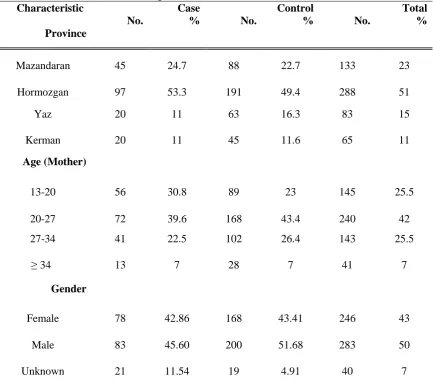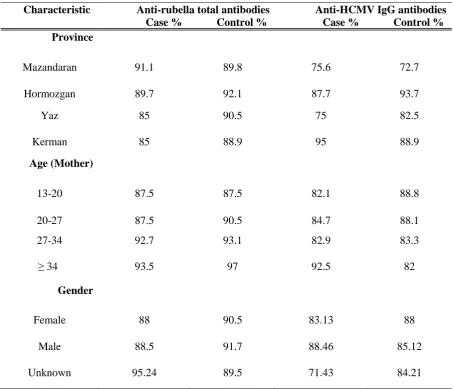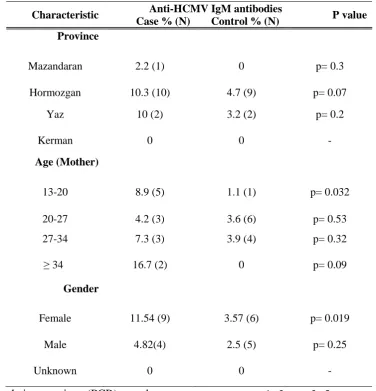Original Article
Prevalence of Rubella and HCMV Antibodies among Neonates
with Congenital Defects in Four Provinces of Iran
Marashi SM1*, Tabatabaei H1, Mahmoodi M2, Nategh R1, Mokhtari-Azad T1
1. Virology center, School of Public Health, Tehran University of Medical Sciences, Tehran, Iran.
2. Epidemiology Department, School of Public Health, Tehran University of Medical Sciences, Tehran, Iran.
Abstract
Background and Aims: Primary infections of rubella and human cytomegalovirus (HCMV) can lead to severe complications in pregnancy. The screening of Rubella and HCMV in pregnant women is not routinely carried out in Iran. This cross sectional study aimed to investigate the seroprevalence of HCMV and rubella infections in neonates with and without congenital defects.
Materials and Methods: This study was carried out in four provinces of Iran including Mazandaran, Hormozgan, Yazd, and Kerman. Demographic data were collected through questioners and samples were taken from umbilical cord bloods of 182 and 387 neonates with and without congenital defects, respectively. To detect HCMV and rubella infections we measured IgG and IgM antibodies using ELISA and HI which were used for measurement of anti-rubella total antibodies.
Results: The prevalence of anti-HCMV IgG antibody was found to be around 90%, while 7.14% of neonates with congenital defects were positive for anti-HCMV IgM antibody compared to 2.84% of control group (p< 0.05). Anti-rubella total antibody was found in 85% and rubella IgM seropositivity rate was 0.5%.
Conclusion: Although not for rubella, the significant correlation found between HCMV IgM positivity and congenital defects highlights the importance of these infections during pregnancy. Routine screening for rubella and HCMV should be introduced for pregnant women in our setting. Although mass rubella vaccination program is introduced in our system since 2004, preventive measures should be taken to decrease the mortality and morbidity related to primary HCMV infections.
Keywords: Rubella; congenital malformations; maternal antibodies; neonates
Introduction
ubella and HCMV infections are major public health concerns when occurring early in pregnancy. Severity of damage or the outcome of infections almost depends on the time at which infection occurs. Maternal infection during the first weeks of gestation
results in nearly all fetuses to become infected, leading to the fetal death, miscarriage or development of congenital defects such as cataracts, mental retardation and hearing loss (1, 2).
Rubella infection is a common cause of exanthamatous disease which predominantly occurs in childhood. The seroprevalence of rubella virus varies and the seropositivity of 54.1% to 95.2% has been reported from different studies conducted in different countries (3-8).
R
*Corresponding author: Seyed Mehdi Marashi, PhD, Virology center, School of Public Health, Tehran University of Medical Sciences, Tehran, Iran. Email: m-marashi@tums.ac.ir
HCMV is endemic all over the world and its prevalence varies from 60% to 100% based on different populations and countries (9). HCMV infection is usually asymptomatic in adults but it is a main public health concern when it occurs during pregnancy. Primary HCMV infection occurs in 0.15 to 2.0% of all pregnancies and in up to 40% of these cases the virus may be transmitted to the fetus whereas this ratio is less than 2% after a recurrent maternal infection with HCMV (10, 11). At birth, perinatal HCMV infection results in symptomatic congenital disease in up to 15% and the majority of these infections are asymptomatic. However, 10 to 15% of those born with asymptomatic congenital HCMV were found to develop significant clinical sequelae (10, 12). As previously indicated, HCMV and rubella virus are increasingly being recognized as important causes of congenital infection. However, a previous exposure to rubella virus actually prevents it from crossing the placenta via protective antibodies produced against the virus; whereas, in HCMV, intrauterine transmission to the fetus can occur irrespective of prior maternal exposure. Surveys correlating congenital malformations and viral agents particularly rubella and HCMV are limited in our country. The aim of our study was to investigate the prevalence of rubella and HCMV antibodies in cord blood samples taken from newborns with and without congenital defects in different parts of Iran.
Methods
This was a cross-sectional study conducted at virology center of school of public health in Tehran University of Medical Sciences (TUMS). Umbilical cord blood samples were collected from 569 neonates with and without congenital defects (182 abnormal and 387 healthy considered as case and control, respectively) attended at the maternity unit of the main state hospitals in four provinces of Iran including Mazandaran, Hormozgan, Yazd, and Kerman. This study was conducted between January 2002 and January 2004
before mass vaccination for rubella and measles in Iran. Demographic data were collected through questioners. In few cases, the gender section of questioners was left empty therefore we categorized them as unknown group. Sera were collected and stored at -20 and -80 until used. Sera were then tested for anti-rubella and anti-HCMV IgM and IgG antibodies using enzyme immunoassay (Biochem-kit, Italy). All suspected results were re-tested by another commercial kit (Behring, German).
Haemagglutination Inhibition Test (HI) was also used to investigate total Rubella antibodies. For the purpose of our study dilutions of 1/8, 1/16, and 1/32 were used. A titer of 1/32 was considered as protective and titer of less than 1/8 considered as no immunity. Titers between 1/8 and 1/32 were repeated and considered positive if only the repeated test was above 1/8.
Statistical Package for Social Sciences (SPSS, version 10.0) software was used to analyse the data. The p-value less than 0.05 was considered statistically significant.
Results
To determine the seropositivity rates of anti-total rubella and anti-HCMV IgG antibodies, cord blood samples were taken from 387 healthy and 182 neonates with congenital defects. Table 1 shows the frequency and distributions of newborns (case and control) according to demographic characteristics such as gender, location, and age. As indicated in table 2, around 90% of neonates with and without congenital defects were shown to be positive for anti-total rubella antibodies. Accordingly, 86.56% of cases and 84.07% of controls were positive for anti-HCMV IgG antibodies and statistically there was no significant difference between cases and controls. However, looking at anti-HCMV IgM antibodies 7.14% of neonates with congenital defects were found to be positive compared to 2.4% of healthy group. The frequency of anti-HCMV IgM antibodies was significantly higher in case group than controls (P= 0.021).
We then analysed data based on gender to check if there is any correlation between CMV IgM seropositivity and gender. Indeed, as shown in table 3 the seropositivity of HCMV IgM was significantly higher in girls born with congenital defects than those without defects (11.54% vs. 3.57%; P= 0.019). Comparing boys with and without congenital defects we could not found such a significant difference. Next we did check the samples for anti-rubella IgM antibodies and none of cases were found to be positive; however, to our surprise two neonates (one girl and one boy) from control group became positive for anti-rubella IgM antibodies.
Discussion
Cytomegalovirus and rubella are major public concern in terms of prenatal and perinatal
infections as these infections can result in main clinical complications on pregnancy for both maternal and fetal health (2, 13).
Human cytomegalovirus is a ubiquitous virus which affects fetus during pregnancy. Although not protective, maternal antibodies do reduce both the rate of virus transmission and the severity of damages to the fetus (14). In our country, except one study where the HCMV IgG seropositivity has been reported to be 72.1% (15) the prevalence of HCMV has been shown between 90 to 97% based on different studies (16). In our study, which was performed on umbilical cord bloods, the HCMV seropositivity rate was found to be around 85%. Our result was similar to the results obtained from other countries in Middle East or Asia such as Turkey (17), Saudi Arabia (18), and Singapore (19).
Table 1. Demographic characteristics and distribution of umbilical cord blood samples taken from neonates with and without congenital defects.
Characteristic Case Control Total
No. % No. % No. %
Province
Mazandaran 45 24.7 88 22.7 133 23 Hormozgan 97 53.3 191 49.4 288 51 Yaz 20 11 63 16.3 83 15 Kerman 20 11 45 11.6 65 11
Age (Mother)
13-20 56 30.8 89 23 145 25.5 20-27 72 39.6 168 43.4 240 42 27-34 41 22.5 102 26.4 143 25.5
≥ 34 13 7 28 7 41 7
Gender
Female 78 42.86 168 43.41 246 43 Male 83 45.60 200 51.68 283 50 Unknown 21 11.54 19 4.91 40 7
Table 2. Frequency of rubella and HCMV antibodies in neonates with and without congenital defects.
Characteristic Anti-rubella total antibodies Anti-HCMV IgG antibodies Case % Control % Case % Control % Province
Mazandaran 91.1 89.8 75.6 72.7 Hormozgan 89.7 92.1 87.7 93.7 Yaz 85 90.5 75 82.5 Kerman 85 88.9 95 88.9
Age (Mother)
13-20 87.5 87.5 82.1 88.8 20-27 87.5 90.5 84.7 88.1 27-34 92.7 93.1 82.9 83.3 ≥ 34 93.5 97 92.5 82
Gender
Female 88 90.5 83.13 88 Male 88.5 91.7 88.46 85.12 Unknown 95.24 89.5 71.43 84.21
Although 7.14% of cases and 2.84% of controls were IgM positive for HCMV, it appears that the rate of IgM seropositivity for HCMV in our populations might be even higher as it has been already shown that in a percentage of cases IgM titer can be undetectable (14). In most cases, congenital infections caused by HCMV are shown to be subclinical at birth (12) that can be a reason why we found anti-HCMV IgM antibodies in 11 neonates (2.84%) who were in control group and showed no clinical sign. It is worth to note that in some cases although there is no sign of congenital inclusion disease (CID) virus reactivation cannot be underestimated or ignored.
In the current study, the prevalence of rubella in mothers was shown to be around 90%, similar to the previous studies performed in our
society on different age groups where the immunity rate against rubella has been reported to be 85% to 95% (20-22). Looking at anti-rubella IgM antibodies, only two samples taken from healthy group were positive. The absence of IgM titer or inability to detect in case group can be explained by small sample size, reduction of IgM titer during freeze and thaw process. As indicated, anti-rubella IgM only detected in two control samples. This may reflect the fact that like HCMV, rubella has delayed clinical symptoms such as deafness which may not be revealed even till 1 year after birth, indicating the possibility of not being considered these two samples as control group. The current study had some limitations such as the lack of follow-up for these women or children in order to document seroconveration and to detect subclinical infections which reveal later. Inability to use
Table 3. Frequency of anti HCMV IgM antibodies in neonates with and without congenital defects.
Characteristic Anti-HCMV IgM antibodies P value Case % (N) Control % (N)
Province
Mazandaran 2.2 (1) 0 p= 0.3 Hormozgan 10.3 (10) 4.7 (9) p= 0.07
Yaz 10 (2) 3.2 (2) p= 0.2 Kerman 0 0
-Age (Mother)
13-20 8.9 (5) 1.1 (1) p= 0.032 20-27 4.2 (3) 3.6 (6) p= 0.53 27-34 7.3 (3) 3.9 (4) p= 0.32 ≥ 34 16.7 (2) 0 p= 0.09
Gender
Female 11.54 (9) 3.57 (6) p= 0.019 Male 4.82(4) 2.5 (5) p= 0.25 Unknown 0 0
-polymerase chain reaction (PCR) to detect viral DNA or RNA can be another limitation of this study.
Conclusion
Although not for rubella, the significant correlation found between HCMV IgM positivity and congenital defects highlights the importance of these infections during pregnancy. Routine screening for rubella and HCMV should be introduced for pregnant women in our setting. Although mass rubella vaccination program was introduced in our system, preventive measures should be taken to decrease the mortality and morbidity related to primary H CMV infections.
Acknowledgements
This study was funded by grant No: 241/78/8 from School of Public Health - Tehran University of Medical Sciences.
References
1. Lee JY, Bowden DS. Rubella virus replication and links to teratogenicity. Clin. Microbiol. Rev. 2000;13(4):571-587.
2. De Santis M, Cavaliere AF, Straface G, Caruso A. Rubella infection in pregnancy. Reproductive Toxicol. 2006;21:390-398.
3. Bukbuk DN, El Nafaty AU, Obed JY. Prevalence of rubella-specific IgG antibody in nonimmunized pregnant women in Maiduguri, North Eastern Nigeria. Cent. Eur. J. Public. Health. 2002;10(1- 2):21-23.
4. Palihawadana P, Wickremasinghe AR, Perera J. Seroprevalence of rubella antibodies among
pregnant females in Sri Lanka. Southeast. Asian. J. Trop. Med. Public. Health. 2003;34(2):398-404. 5. Odland JO, Sergejeva IV, Ivaneev MD, Jensen IP, Stray-Pedersen B. Seropositivity of cytomegalovirus, parvovirus and rubella in pregnant women and recurrent aborters in Leningrad County, Russia. Acta. Obstet. Gynecol. Scand. 2001;80(11):1025-1029.
6. Tolfvenstam T, Enbom M, Ghebrekidan H, Ruden U, Linde A, Grandien M, Wahren B. Seroprevalence of viral childhood infections in Eritrea. J. Clin. Virol. 2000;16(1):49-54.
7. Best JM., Banatvala JE. Rubella. In: Principles and Practice of Clinical Virology. Eds. Zuckerman AJ, Banatvala JE, Pattison JR, Griffiths PD, Schoub BD), Fifth Edition, John Wiley and Sons, Ltd., West Suusex, England. 2004;427-457.
8. Haas DM, Flowers CA, Congdon CL. Rubella, rubeola, and mumps in pregnant women: susceptibilities and strategies for testing and vaccinating. Obstet. Gynecol. 2005;106(2):295-300.
9. Ho M. Epidemiology of cytomegalovirus infections. Rev. Infect. Dis. 1990;12: S701-710. 10.Stagno S, Pass RF, Cloud G., Brittw J, Henderson RE, Walton PD, Veren DA, Page F, Alfrod CA. Primary cytomegalovirus infection in pregnancy. Incidence, transmission to fetus, and clinical outcome. JAMA. 1986;256(14):1904-1948. 11.Griffiths P, Babnian C, Ashby D. The demographic characteristics of pregnant womwn infected with cytomegalovirus. Int. J. Epidemiol. 1985;14:447-452.
12.Boppana BS, Fowler BK, Britt JW, Stagno S, Pass FR. symptomatic congenital CMV infection in infants born to mothers with preexisting immunity to cytomegalovirus. Pediatries.1999; 104:55-56. 13.Griffiths PD. Cytomegalovirus (In: Principles and Practice of Clinical Virology. Eds. Zuckerman AJ, Banatvala JE, Pattison JR, Griffiths PD, Schoub BD), Fifth Edition, John Wiley and Sons, Ltd., West Suusex, England.2004; 85-122.
14.Daniel Y, Gull, Pcyser R, Lessing JB. Congenital CMV infection. Eur J obested Gynecol. 1995;63:157-160.
15.Bagheri L, Mokhtarian H, Sarshar N, Ghahramani M. Seroepidemiology of Cytomegalovirus Infection during Pregnancy in Gonabad, Eastern Iran: A Cross-Sectional Study. Journal of Research in Health Sciences. 2012;12(1):45-49.
16.Tabatabaee M and Tayyebi D. Seroepidemiologic study of human cytomegalovirus in pregnant women in Valiasr Hospital of Kazeroon, Fars, Iran. Journal of Maternal-Fetal and Neonatal Medicine. 2009;22(6):517-521.
17.Uyar Y, Balci A, Akcali A, Cabar C. Prevalence of rubella and cytomegalovirus antibodies among pregnant women in northern Turkey. New Microbiologica. 2008;31:451-455 ,
18.Ghazi HO, Telmesani AM, Mahomed MF. TORCH Agents in Pregnant Saudi Women. Med. Princ. Pract. 2002;11:180-182.
19.Wong A, Tan KH, Tee CS, Yeo CSH. Seroprevalence of Cytomegalovirus, Toxoplasma and Parvovirus in Pregnancy. Singapore. Med. J. 2000;41(4):151-155.
20.Majlessi F, Batebi A, Shariat M, Rahimi A, Azad TM. Rubella serology in pregnant women attending health centres of Tehran University of Medical Sciences. East Mediterr Health J. 2008;14(3):590-4
21.Doroudchi M, Dehaghani AS, Emad K, Ghaderi AA. Seroepidemiological survey of Rubella immunity among three populations in Shiraz, Iran. East Mediterr Health J. 2001;7:128-138.
22.Sotoodeh Jahromi A, Kazemi A, Manshoori G, Madani A, Moosavy SH, Seddigh B. Seroprevalence of Rubella Virus in Women with Spontaneous Abortion. American Journal of Infectious Diseases. 2011;7(1):16-19.


